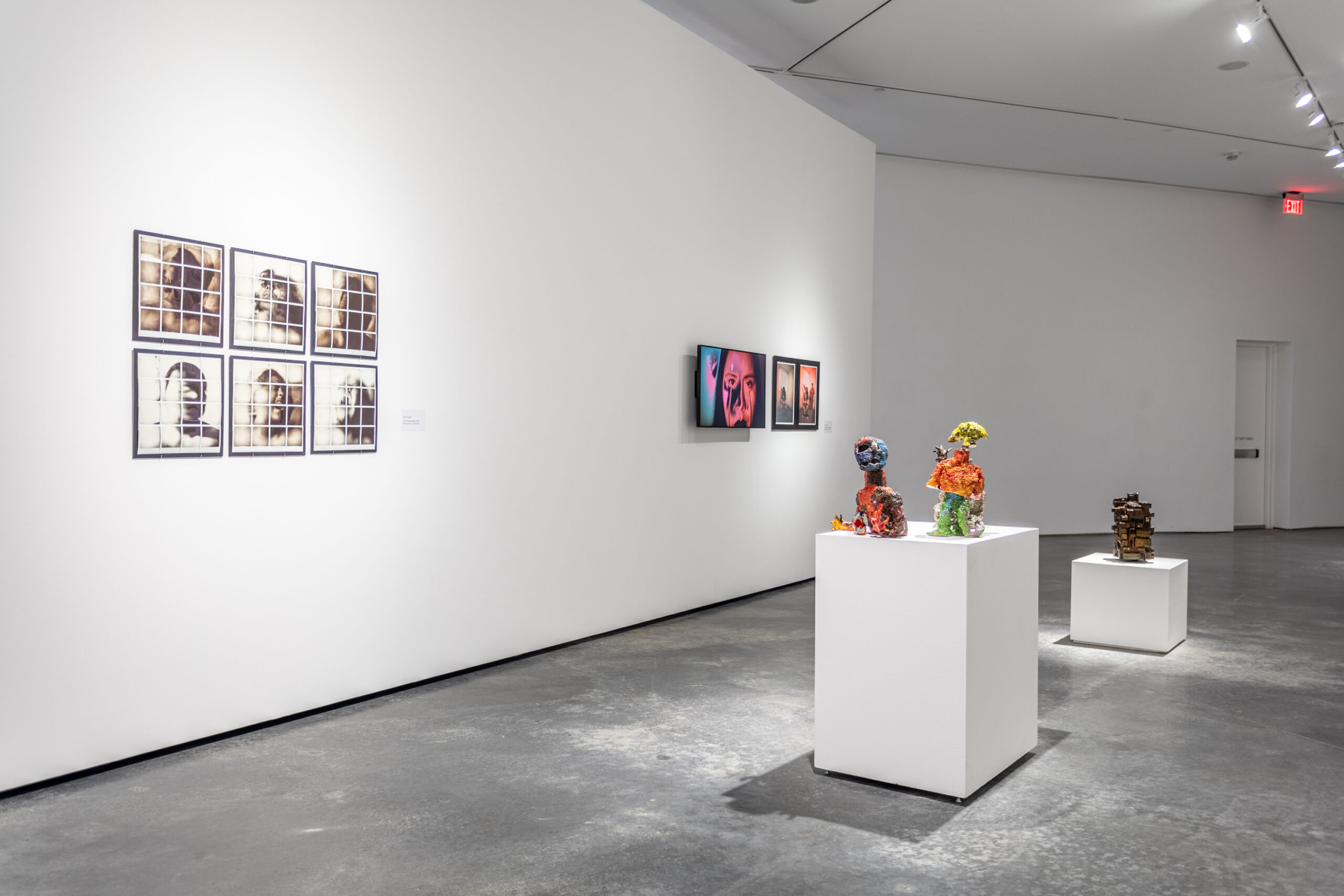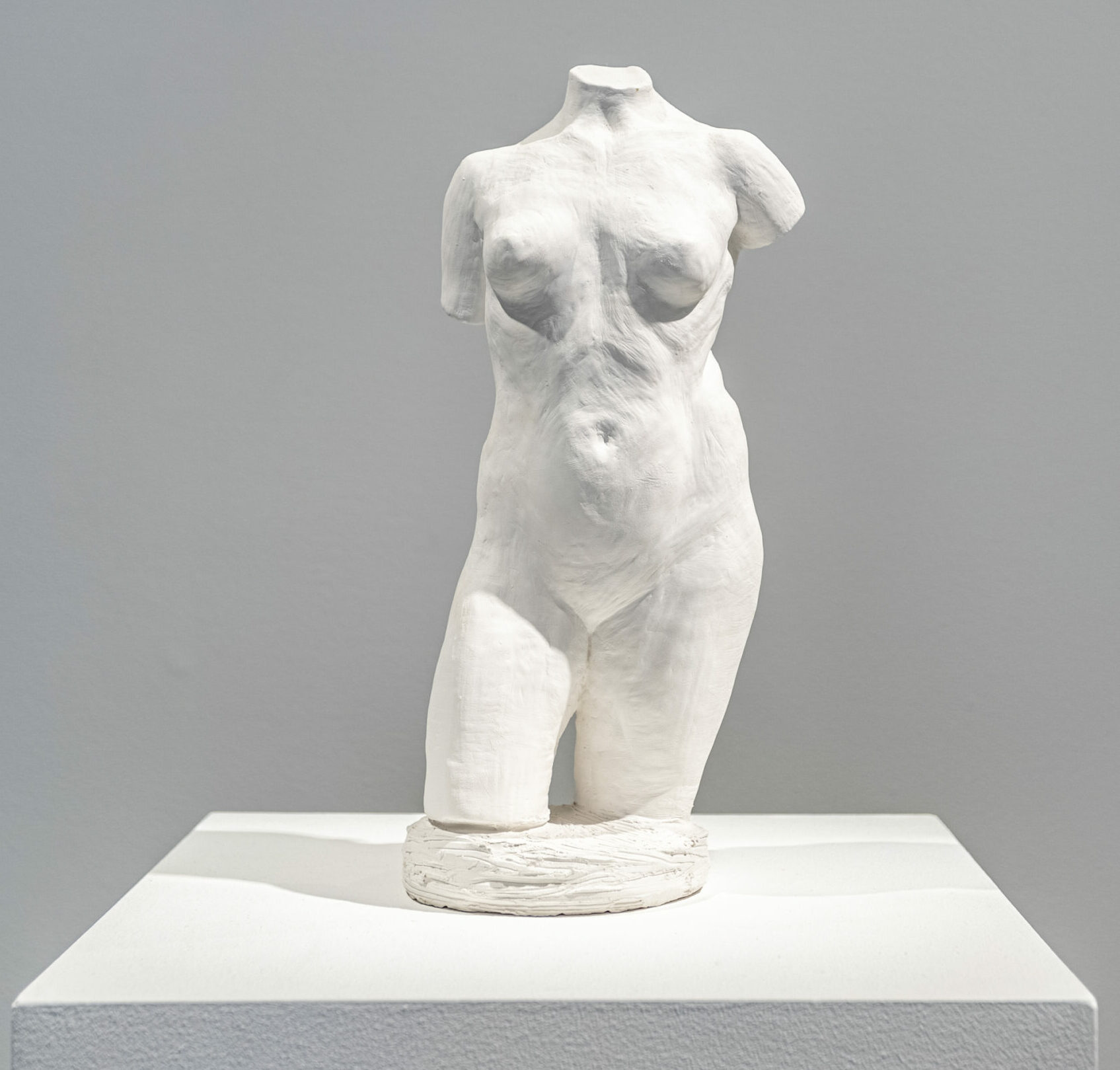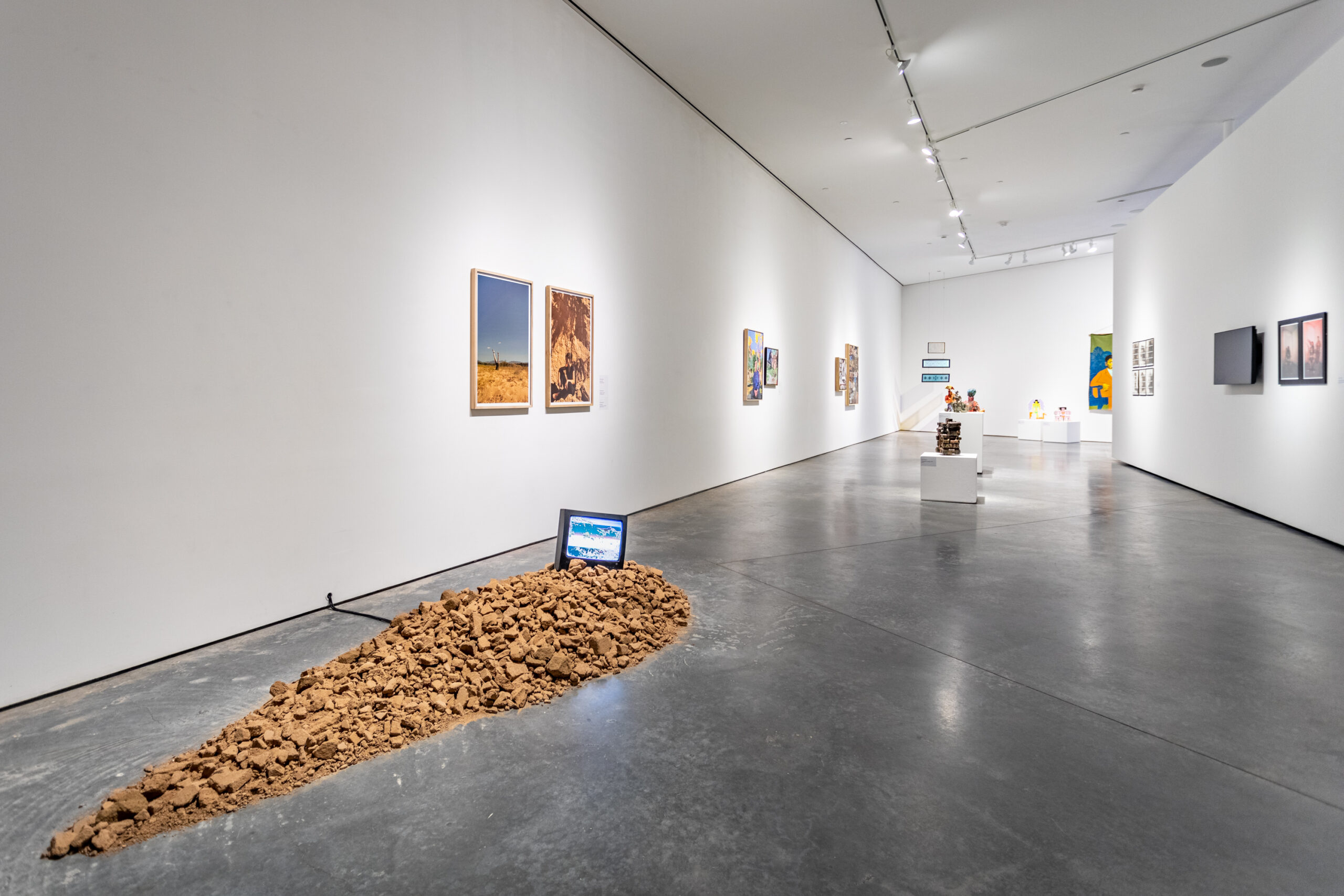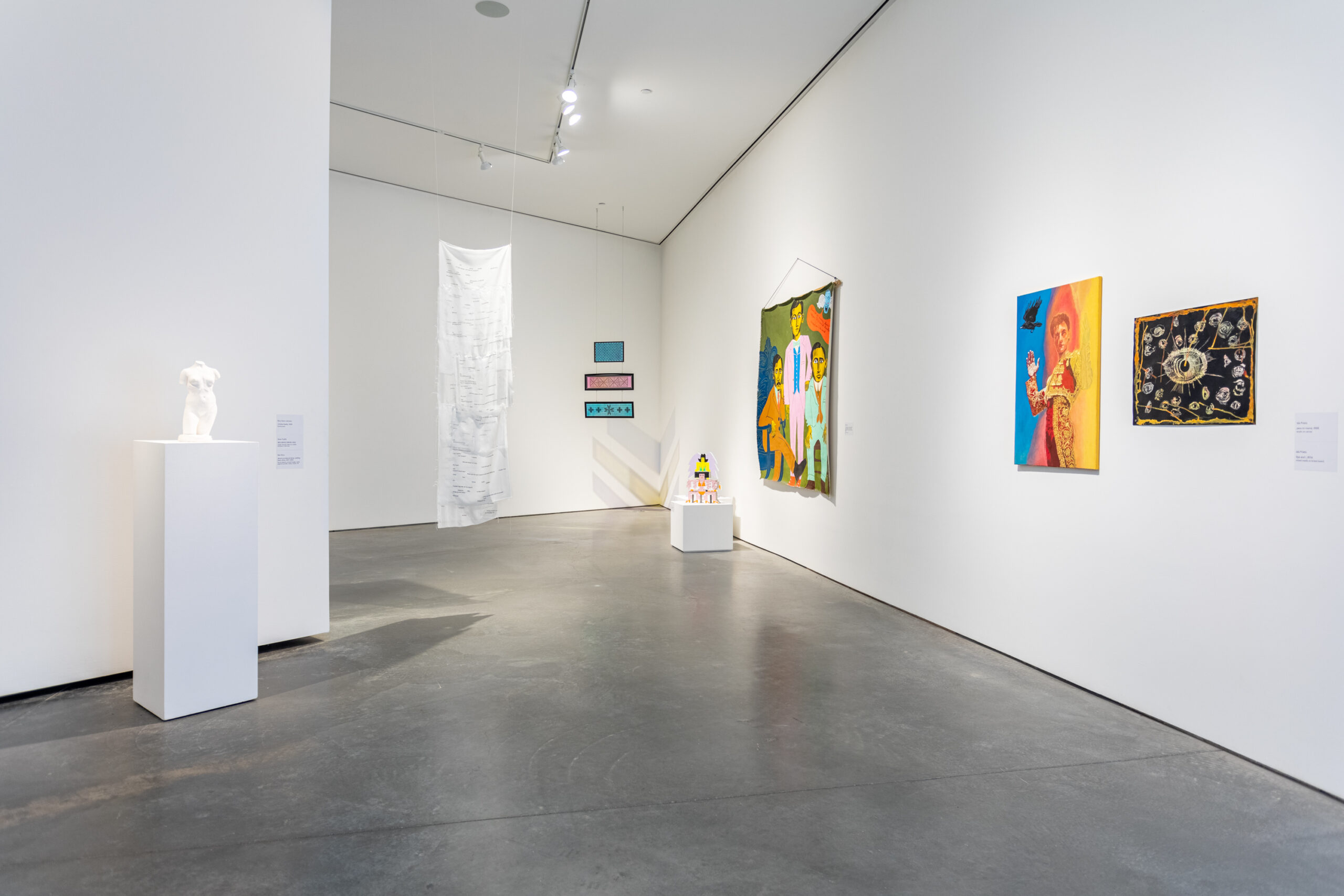Shaping Tomorrow’s Curators Today
SITE Santa Fe program encourages teens to see, select, think and write about art
By Louis Abbene-Meagley, Saint Garrett, Elena Bunker Ruiz, Helayna Bell, Solis Lucero and Vanezia Aguayo
SITE’s Young Curators Program is a free afterschool program that teaches high school students the curatorial side of the art experience and provides ways for teens to connect with art, while giving them a glimpse of possibilities within museum careers. Every year, teens organize and curate their own exhibition, and also learn how to think and write critically about exhibitions throughout Santa Fe. Participants in the Young Curators program are empowered to make decisions about their exhibition’s theme, selection of artworks, PR and marketing, fundraising, installation and opening events.
Two major inspirations took clear focus for this year’s group of five curators: the growing climate and pollution crisis, and the uncanny valley. The climate and pollution crisis is a very real and dangerous issue that threatens every living thing on the planet. The uncanny valley is a term for the phenomenon of seeing things we know to be robotic and non-living but that take on a human appearance that looks and feels creepy or uncomfortable.
Together, these two subjects overlap to make up an area of discomfort that challenges the viewer to both look and look away. Just as piles of trash, single-use plastics and micro plastics have blown up to gargantuan levels in our landfills and our oceans, so (it has felt) has the silence around the issue.
The exhibition reviews below, by the five members of this year’s Young Curators Program, were done with the intent to showcase local exhibitions happening during the spring season. The SITE Scholars exhibition that some of these curators reviewed is a yearly showcase of artists in graduate and undergraduate programs in the area who are nominated by their teachers. The nominated students then submit proposals to SITE, and we accept artworks from each of the students based on their proposals.
Teens ages 13-18 can apply in August to be a part of the Young Curators Program. Applicants need to be from New Mexico and able to attend a one-hour meeting every week after school between September and May. Find more information here.
– Louis Abbene-Meagley, Education Manager, SITE Santa Fe

A Vibrant, Visual Hug
Vibrant complemented cool earth tones, muted homey emotions, being hurt, resonated pain, intense deep feelings, fabric-y, disheartening, neutral.
The work of the students in the SITE Scholars exhibition is highly vibrant. The works all complement each other neatly with cool, earthy tones. Muted shades that envelop the viewer in home-like emotions hurt; the pain resonates within. The art is like fabric to the eyes. It is disheartening in a neutral, comfortable way.
Within the 2022 SITE Scholars exhibition is a highly vibrant collection of different works. Despite their differences, they share nearly the same color palette with mainly complimenting features to match. The subdued shades envelope the audience within a warm hug.
Inside of the 2022 SITE Scholars exhibition, there are faded purples, dusty blue tones and crisp white edges. Despite the artworks’ differences, each piece within the space shares a familiar memory of times forgotten and times remembered. The works envelope the viewer in a bronze-like fabric of feeling and bring them into a space like home. Somehow, despite the love the viewer is circled in, the pain begins to start at the feet, move up the body and find its way up to the head only leaving a dull ache within.
– Saint Garrett

Subverting Typical Narratives
The 2022 SITE Scholars show is an eclectic collection of intimate works, rich with a variety of mediums ranging from photography to sculpture. Rory Quinn Johnson’s Untitled (Belly) greets the audience at the front door. It is a small yet bold, off-white body, with jutted severed thighs and shoulders. This work gives an initial hint of how the art correlates with a distinct narrative; one that is close to the artist. The broken bust is a reference to ancient Greece, but still manages to carry new meaning in its earthenware material despite its historical context. It is defiant against the pressured male gaze instilled within the history of nude artwork. Belly is unafraid to depict bodily “imperfections” sometimes considered not beautiful. It even encourages the viewer to focus on these imperfections by removing the figure’s head.
This is not the only figurative piece in the show. As another piece showcases the artist’s figure buried in dry dirt – taking the notion of embracing one’s surroundings quite literally. To stretch this concept even further, the video is displayed on an old television, surrounded by the very same dirt featured in the video; this makes it a sculptural piece as well. Having the dirt escape the screen into the sculptural realm makes the piece feel more immersive – a strong conceptual choice on the part of the artist, giving the viewer the same feeling of all-encompassing dirt.
Across the way from this piece is Carmen Selam’s video work and photography series. The video depicts a native woman drawing black tears down her cheeks. Teardrops are a common symbol of sorrow, but this piece manages to use the symbolism in a much more layered way. The contrast between the purely black tears and the rest of the hazy colors is striking and conveys a kind of anger in the strength of the line as well as a sorrow. Accompanying this video are two photographs. In these photos there are figures fully garbed. Their dress indicates a cultural identity intended to be shared with the viewer and tied to the emotions that the piece depicts.
Amidst all the dreamy colors, the strength of the black linework stands out. It grounds the viewer amongst garbled and disorienting light and allows for the focus of the artist’s intense emotions and clothes to push through. The gallery’s tight knit visual language stems from many personal voices. Being an unspoken allegory for each artist’s qualms, strengths and or interests. It’s a visual narrative that separates the body from normal narratives within stereotypical patriarchal behavior, and in doing so allows for a more intimate and close interaction with the viewers.
The show, and all the pieces in it, conjointly manage to subvert typical patriarchal narratives. And in doing so, either challenge, or corroborate with, the viewer’s sense of themselves. By diverging from stereotypes, we can diversify artwork to connect more intimately and closely with ourselves.
– Elena Bunker Ruiz and Helayna Bell

The Power of Eyes
I don’t know where to start, but I know I like eyes. I like eyes very, very much. I think they are so cool, and I used them to see a piece of art. I think it was embroidered but it had a lot of eyes on it. I don’t know, I think eyes are a real tool for imagery. The way that they just stare into the viewer feels like a very personal experience, almost like a conversation with the art piece as it talks to the viewer about whatever comes to mind. I think that an experience with a piece of artwork that is so personal and heartfelt as this is already as close knit as it could be.
In the Site Scholars 2022 show, there was an artist that had a tapestry with eyes embroidered into the fabric. The use of line work in the form of thread was rather impressive considering the medium. Maybe I’m just saying that because embroidering blows my mind. The use of the minimal color pallet is refreshing; a simple black cloth and golden yellow threading are used in place of the iris. The eyes help to complete the piece with these dark round circles. The next work consisted of a painting of a figure in vibrant reds and blues and yellows. The use of those bright colors next to the muted and dark shades of its twin piece left me looking back at the eyes.
– Solis Lucero

Capturing and Redefining Stories
During my time in the Young Curators, I visited three different art spaces, each with unique bodies of work.
First was the Art Vault, the exhibition space of the Thoma Foundation in the Railyard. The Art Vault has a variety of collections of historical, contemporary and worldly artworks. Viewers get to see new and exciting types of art media, which contrast from art of the female power, to weird, white, stampeding balls. The Vault allows visitors to interact with the world of science experiments involved in the arts. In a particular piece, the gallery shows multiple faces, female and male, in a single photo, to determine which gender would dominate the image. In a very favorable new recreation of the historical artwork “The Garden of Earthly Delights,” Carla Jannis took this piece of work and transformed it into new media; using emojis she manipulates them by mimicking the original artwork. Jannis also included movement and sudden changes in their digital work.
The Art Vault has great visuals and focuses on bringing technology into its collection with new creative experiences. With the many video installations in the rooms, it’s sometimes difficult to focus eyes on other works; some even feel too close to one another. In my opinion, I feel that the artworks deserve more space, so that they are included in an equal way to each other.
Next was the New Mexico Museum of Art. This museum focuses on artists in New Mexico. The art tells a story from the Native American perspective with different old school or traditional media. It includes the history, culture, communities and regions behind many New Mexican lives. Viewers get to experience the works of historical artists through educational but artistic ways. Overall, it’s an enjoyable experience that helps New Mexican history stay alive and remembered.
Through the museum’s substantial collection of history, its modern arts provide connections to education and learning. Although it would have been even more beneficial if the museum included further information about the artist and their relation to New Mexico, I still felt like I learned a lot.
The last visit was to Form and Concept. This gallery on S. Guadalupe Street shows media of international and regional artists interacting with communities through their creative minds. It gives historical meanings behind an artist, their work and the material they provide. The museum goes to many creative lengths to highlight these artworks, such as rebuilding a sculpture which was burned recently. Instead of taking the work down, they decided to make the piece complete once again.
In my absolute opinion, I believe that the gallery takes great focus on artworks. My only suggestion would be more space and more artworks from different media (such as digital), due to it solely being sculptures or paintings.
In conclusion, overall, these museums and galleries have phenomenal works from all over the world with diverse stories. Each space shows these works in a variety of positive and admiring ways for many to see and learn upon.
– Vanezia Aguayo



